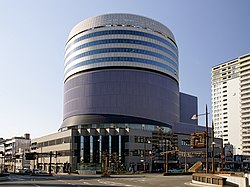|
Yoshinobu Ashihara
Yoshinobu Ashihara (芦原 義信, Ashihara Yoshinobu, 7 July 1918 – 24 September 2003) was a Japanese architect noted for projects such as the Komazawa Olympic Gymnasium (1964) and the Sony Building (1966). Education and careerAshihara was educated at both the University of Tokyo and Harvard University. After graduating from Harvard in 1953 with a master's degree in Architecture, Ashihara worked in the architectural practice of modernist Marcel Breuer. Founder of his own firm Yoshinobu Ashihara Architecture Associates in 1956. In the later stages of his career, he was appointed Professor of Architecture at the University of Tokyo. President of the Japan Institute of Architects from 1980 - 1982 and the Architectural Institute of Japan from 1985 - 1987.[1] He was the recipient of both the Order of the Sacred Treasure and the Order of Culture. Projects
PublicationsAshihara published a large number of architecture focused studies and texts, most prominent being The Aesthetic Townscape (Japanese first edition 1979 and English translation in 1983) and the Hidden Order: Tokyo through the Twentieth Century (Japanese first edition 1986, English translation in 1989). See alsoReferences
External linksWikimedia Commons has media related to Yoshinobu Ashihara.
|
|||||||||||||||||||||||||||||||||||||||||||||||||||||||||||||||||||
Portal di Ensiklopedia Dunia







